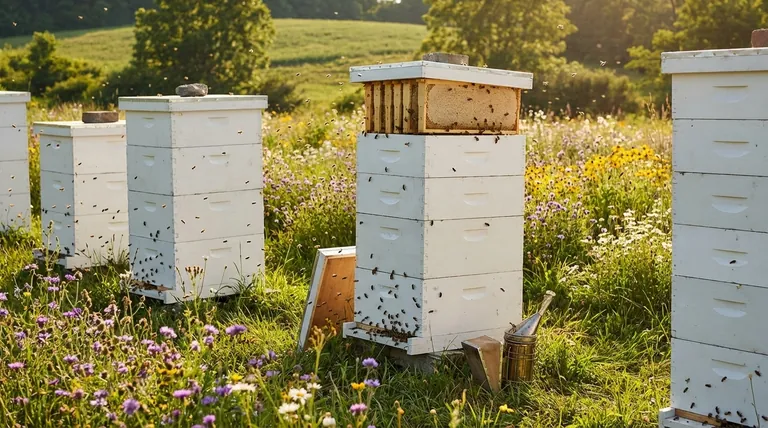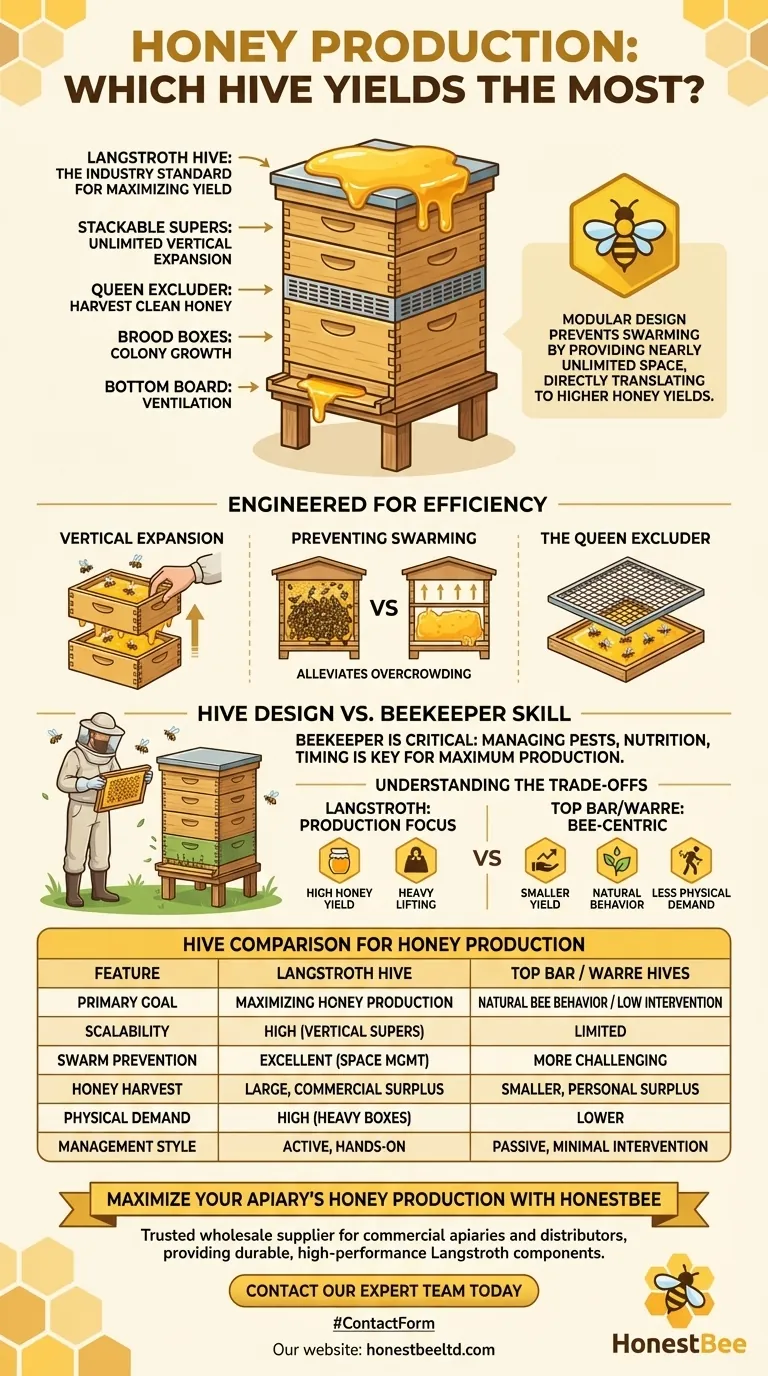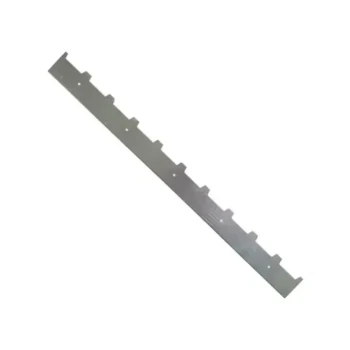For maximizing honey production, the Langstroth hive is the industry standard. Its design is fundamentally centered around scalability and efficient management, allowing a beekeeper to expand the hive vertically to accommodate a massive workforce and nectar flow, directly translating into higher honey yields.
The choice of hive is less about a magic box and more about a system of management. The Langstroth design prevails for honey production because its modular, vertically expandable nature is the most effective tool for preventing swarming and giving bees nearly unlimited space to store surplus honey.

The Langstroth Hive: Engineered for Production
The Langstroth isn't just a box; it's a modular system developed in the 19th century specifically to make bee management and honey harvesting more efficient. Its dominance in commercial apiaries is a direct result of its design philosophy.
The Principle of Vertical Expansion
A strong colony's population can explode during a nectar flow. The Langstroth hive's core advantage is its use of stackable boxes, known as "supers."
As the bees fill one box with honey, the beekeeper can simply add another on top. This provides virtually unlimited space, encouraging the bees to continue foraging and storing nectar far beyond what the colony needs for its own survival.
Preventing Swarming
Swarming is the natural way a colony reproduces, but it is the enemy of honey production. When a colony swarms, it loses up to half its workforce, crippling its ability to gather a large honey surplus.
The primary trigger for swarming is a sense of being overcrowded. By adding supers ahead of the colony's needs, the beekeeper relieves this congestion, effectively persuading the bees to stay and focus their energy on honey production.
The Role of the Queen Excluder
A key component in the Langstroth system is the queen excluder. This is a grid placed between the lower brood boxes (where the queen lays eggs) and the upper honey supers.
The grid is large enough for worker bees to pass through but too small for the queen. This ensures the honey supers contain only honey, free from eggs and larvae, which drastically simplifies the harvesting process.
Hive Design vs. Beekeeper Skill
While the Langstroth is the superior tool for the job, the hive itself produces nothing. A skilled beekeeper with a mediocre hive will always outperform a novice with the best equipment.
The Beekeeper is the Critical Factor
Hive selection is only one part of the equation. Maximizing honey production depends entirely on the beekeeper's ability to maintain a healthy, populous colony.
This includes managing pests like Varroa mites, ensuring proper nutrition, and timing hive manipulations (like adding supers) correctly to match the local nectar flow.
Other Hives Can Produce Honey
Other designs, like the so-called "universal hive," can be managed for honey production. However, they often require more complex interventions, such as using division boards to manipulate colony space.
Hives like the Top Bar or Warre are designed around different principles, often prioritizing more natural bee behavior and less intrusive management. While they produce honey for the bees and a small surplus for the keeper, they are not designed to generate the large yields possible with a Langstroth.
Understanding the Trade-offs
Choosing a hive is a commitment to a specific management style. The Langstroth's focus on production comes with clear trade-offs.
Production vs. Bee-Centric Management
The Langstroth system is a tool for agricultural production. Every component is designed to be interchangeable and to make inspection and harvesting efficient.
This contrasts with hives like the Warre, which are managed with the goal of disturbing the colony as little as possible. This may be arguably better for the bees' natural inclinations but is far less efficient for the beekeeper focused on a large harvest.
The Burden of Weight
The primary drawback of the Langstroth system is weight. A full deep hive body can weigh over 80 pounds, and a full honey super can easily weigh 40-60 pounds.
Managing a tall stack of these boxes requires significant physical strength, which is a major reason some beekeepers opt for alternative, horizontally-oriented hives like the Top Bar.
Making the Right Choice for Your Goal
Your primary objective as a beekeeper should dictate your choice of equipment.
- If your primary focus is maximizing honey yield: The Langstroth hive is the undisputed choice due to its unmatched vertical scalability and standardized, efficient components.
- If your primary focus is a more natural or less physically demanding approach: Consider a Top Bar or Warre hive, but be prepared for significantly smaller honey harvests.
- If your primary focus is versatility and advanced management: A hive with features like division boards may appeal to you, but it is not the most direct path to high-volume production.
Ultimately, the right hive is the one that best empowers you to keep your colonies strong, healthy, and productive.
Summary Table:
| Feature | Langstroth Hive | Top Bar / Warre Hives |
|---|---|---|
| Primary Goal | Maximizing Honey Production | Natural Bee Behavior / Low Intervention |
| Scalability | High (Vertical, Stackable Supers) | Limited |
| Swarm Prevention | Excellent (Via Space Management) | More Challenging |
| Honey Harvest | Large, Commercial Surplus | Smaller, Personal Surplus |
| Physical Demand | High (Heavy Boxes) | Lower |
| Management Style | Active, Hands-On | Passive, Minimal Intervention |
Ready to maximize your apiary's honey production?
As a trusted wholesale supplier for commercial apiaries and distributors, HONESTBEE provides the durable, high-performance Langstroth hive components and equipment you need to scale your operations efficiently. Our focus on wholesale ensures you get the reliable tools for superior hive management and bigger harvests.
Contact our expert team today to discuss your commercial beekeeping supply needs.
Visual Guide

Related Products
- HONESTBEE Professional Hive Top Bee Feeder Feeding Solution
- Multi-Functional Sliding Hive Entrance for Beekeeping
- Stainless Steel 9 Frame Hive Spacer Durable Precise for Commercial Beekeeping
- Professional Drop-Style Hive Handles for Beekeeping
- Professional Galvanized Hive Strap with Secure Locking Buckle for Beekeeping
People Also Ask
- How is the plywood floor fitted into the hive-top feeder? Ensure Longevity with a Floating Floor Design
- What is a top feeder for bees? Maximize Colony Health with Efficient Feeding
- Do I need an inner cover with a hive top feeder? Optimize Your Hive Setup for Healthy Bees
- Why is a top feeder essential for bees? Ensure Colony Health and Efficiency
- What should be done with feeders and equipment after feeding bees? Essential Steps for Apiary Health



















